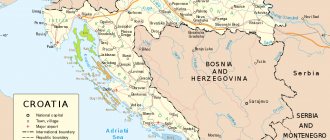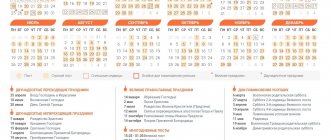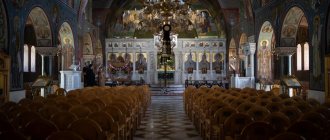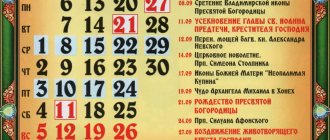Orthodox holidays are the basis of the functioning of the Church. Believers free themselves from the bustle of the world, devoting time to serving the Lord, reading prayers, and performing established rituals. The solemnity and method of holding a particular holiday is determined by its importance, and the main church dates (Christmas, Easter) play a key role in Orthodoxy.
Church holidays: historical excerpts
Dates in honor of which the Church and all its parishioners offer prayers to the Lord date back to the times of the Old Testament. Adjacent to the ancient rituals are New Testament traditions dedicated to stories from the life of Christ, the Mother of God and the saints.
Giving Christian holidays an incredibly high status, the Church tried to determine the daily routine of Christians on these days. Orthodox believers were freed from work and everyday routine, devoting themselves entirely to worship.
In the IV – VI centuries. The Byzantine authorities, who fully patronized the institution of the Church, issued strict laws that prohibited violating the sanctity of holidays, suppressing labor and noisy entertainment. Emperor Constantine went the furthest, abolishing trade on Sundays.
Today, the nature of Orthodox holidays has been modified, although some days remain official public holidays. Similar laws exist in most Christian-majority countries.
Russian Orthodox Church calendar calculator
A simple calculator that can calculate church holidays and fasts by month. You can easily find out on what day a particular Christian holiday or fast will occur. Non-transitional dates are displayed immediately; for transitional dates (depending on Easter), calculations are made for the selected year.
Your browser must allow javascript, it is enabled by default unless you change the settings. Set the year using the arrows (when you hover your mouse over the input window) or simply enter the number and click the “Calculate!” button. If necessary, repeat the calculation for another year. By default, dates are calculated for 2021.
Attention: all dates are given according to the Julian calendar (old style).
Permanent holidays and fasts
The church year begins in September and ends in August (Julian calendar).
September 1. Church New Year. 8 September. Nativity of the Blessed Virgin Mary. September 14. Exaltation of the Cross of the Lord, one-day fast. October 1st. Protection of the Blessed Virgin Mary. 15th of November. The beginning of the Nativity Fast. November 21. Presentation of the Blessed Virgin Mary into the temple. December 24. The last day of the Nativity Fast (Christmas Eve), fasting until the first star. December 25th. Nativity. The beginning of Christmastide (a continuous week without fasting). 1st of January. Circumcision of the Lord and the memory of St. Basil the Great. 4 January. Last day of Christmastide. 5 January. Epiphany Christmas Eve (Epiphany Eve), one-day fast. 6th January. Baptism of the Lord (Holy Epiphany). February 2. The Presentation of the Lord (if the Presentation falls on Monday of the first week of Lent, then the festive service is moved to February 1). March 25. Annunciation of the Blessed Virgin Mary. June 24. Nativity of John the Baptist. June 29. Memorial Day of the Holy Apostles Peter and Paul. August 1. The beginning of the Assumption Fast. August 6. Transfiguration. August 14. The last day of the Dormition Fast. August 15. Dormition of the Blessed Virgin Mary. August 29. Beheading of John the Baptist, one-day fast.
Moving holidays and fasts
Enter the year:
Calculation range: 988 to 4068.
In 988 AD. (6496 AD) the Baptism of Rus' took place, the adoption of Christianity as the state religion of the Russian state. 4068 AD (9576 AD) is the last year of the 18th Indiction. More details about this are written in the book “Biblical Chronology”
.
Church calendar
The Orthodox calendar, which annually determines the exact dates of celebrations, includes two parts: we are talking about moving and non-moving holidays. Immovable holidays come from the Julian calendar, which does not coincide with the calculations of its Gregorian counterpart within 13 days. Permanent celebrations are characterized by the presence of a constant date that does not change depending on the month or day of the week.
Moving holidays “float” according to the calendar, and the key reference point for their appointment is Easter, which is determined according to the lunar calendar and a number of religious tenets prohibiting the celebration of Easter:
- simultaneously with the Jewish Church;
- before the spring equinox;
- until the first spring full moon.
Taken together, the two parts of the calendar of church holidays make up a complete cycle.
Orthodox calendar
1.2. Great holidays - what are they?
There are more than enough holidays in the Orthodox calendar. By and large, every day of the calendar is famous for something. After all, believers devote every day of the year to remembering special events for Christians or the memory of saints. But these holidays are unequal in importance.
How are church services organized?
The annual circle of worship helps church ministers devote each day either to the remembrance of special biblical events or to the memory of numerous saints.
The circle of the seventh, that is, weekly service indicates the days of the week dedicated to memories of special events:
• Sunday is dedicated to the Resurrection of Christ
• Monday - to the angels of God
• Tuesday - to the prophets
• Wednesday - fast day, dedicated to the betrayal of Christ by Judas
• Thursday - saints of Christianity
• Friday is a fast day, dedicated to the crucifixion of Christ on the cross
• Saturday - dedicated to the saints of the Orthodox Church and the departed.
The daily worship service includes nine church services:
• evening and night - Vespers, Compline, Midnight Office, Matins
• daytime - services of the first, third, sixth, ninth hours
• liturgy, or mass - the central divine service, is also performed daily.
But we, the laity, do not need to delve into such subtle details of the life of the Orthodox Church. After all, no matter how churchgoers people are, they are still attached to secular life, and few people can devote their every day around the clock to serving God. It is important for us to know Orthodox holidays, special, most important dates on the calendar.
So, what kind of holidays are there?
The Twelfth Feasts are the twelve great holidays of the annual cycle of worship. The twelfth holidays are divided into:
The Lord's - dedicated to Jesus Christ
Theotokos - dedicated to the Blessed Virgin Mary
The twelfth holidays are divided into movable (movable) and immovable (fixed) holidays. The dates of the moving holidays fall on different dates each year and are calculated depending on the day of Easter. Actually, Easter does not belong to the twelve holidays.
Non-twelfth holidays are the remaining holidays reflected in the Orthodox calendar.
Holidays of the Orthodox calendar are divided by importance into:
- great
- average
- small.
The great holidays include the twelve and Easter, or the Resurrection of Christ. Great holidays are distinguished by the special solemnity of worship.
Orthodoxy: spectrum of holidays
The Church classifies services based on their importance, distinguishing between Great, Medium and Small. The main event in Orthodoxy is the Resurrection of the Lord. The Twelveth and several other holidays are considered Great.
The Twelfth Feasts are 12 religious events dedicated to the chronicles of the earthly life of Christ and his entourage. The liturgical principle distributes them within the annual circle into:
Fixed, falling on certain (non-changing) dates
- 01/07 Christmas
- 19.01 Epiphany
- 15.02 Meeting
- 07.04 Annunciation
- 19.08 Transfiguration of Christ
- 28.08 Dormition of the Mother of God
- 21.09 Nativity of Mary
- 27.09 Exaltation of the Cross
- 04.12 Introduction to the Temple of the Virgin Mary
Movable (moving along calendar pages relative to Easter)
- One week before: Jesus' entry into Jerusalem.
- On the 40th day after: The Ascension of Jesus.
- On the 50th day after: Trinity Day.
The spectrum of the Great is completed by non-Twelfth celebrations
- Circumcision (14.01);
- Nativity of John the Baptist (07.07);
- Feast of Peter and Paul (12.07);
- Beheading of John the Baptist (11.09);
- Protection of Mary (14.10).
Great Orthodox days also include all Sundays - on the last day of the week, all worldly problems must be postponed until tomorrow, devoting time to visiting church and reading prayers.
Orthodox calendar - old and new style
Both of these arguments are quite convincing for an Orthodox believer. However, they do not seem to relate to the Julian calendar as such. After all, the Church did not create a new calendar, but adopted the one that already existed in the Roman Empire. What if the calendar were different? Perhaps then it would be precisely that other calendar that would have been consecrated for liturgical use, and it would have been with this in mind that the Easter calendar would have been compiled?
This article is an attempt to consider some aspects of the calendar problem, providing the reader with material for independent reflection. The author does not consider it necessary to hide his sympathy for the Julian calendar, but he is aware that it is impossible to prove its superiority in any way. Just as the advantage of the liturgical Church Slavonic language over Russian or the icons of St. Andrey Rublev in front of Raphael's painting.
The presentation will be carried out in three stages: first, brief conclusions, then a more detailed mathematical justification, and, finally, a short historical sketch.
Any natural phenomenon can be used to measure time and compile a calendar if it repeats evenly and periodically: the change of day and night, the change of phases of the Moon, seasons, etc. All these phenomena are associated with certain astronomical objects. In the book of Genesis we read: And God said: Let there be lights in the firmament of the heaven for... times, and days, and years... And God created two great lights: the greater light to rule the day, and the lesser light to rule the night, and the stars
(Gen. 1, 14-16). The Julian calendar is compiled taking into account the three main astronomical objects - the Sun, the Moon and the stars. This gives grounds to consider it a truly biblical calendar.
Unlike the Julian calendar, the Gregorian calendar takes into account only one object - the Sun. It is designed in such a way that the point of the vernal equinox (when the lengths of day and night are equal) would deviate as slowly as possible from the date of March 21. At the same time, the connection between the calendar and the Moon and stars was destroyed; in addition, the calendar became more complex and lost its rhythm (compared to the Julian calendar).
Let's look at one property of the Julian calendar that is most often criticized. In the Julian calendar, the vernal equinox moves backward along calendar dates at a rate of approximately 1 day every 128 years. (In general, the difference between the dates of the Julian and Gregorian calendars is currently 13 days and increases by 3 days every 400 years.) This means, for example, that the day of the Nativity of Christ, December 25, will eventually move to spring. But, firstly, this will happen in about 6000 years, and secondly, even now in the southern hemisphere, Christmas is celebrated not even in the spring, but in the summer (since December, January and February are the summer months there).
Taking into account all of the above, we can conclude that the statement “the Gregorian calendar is more accurate than the Julian calendar” is far from indisputable. Everything here is determined by accuracy criteria, and they can be different.
To substantiate the above statements, we present some astronomical and arithmetic arguments and facts.
One of the main periods of time for us is a year. But it turns out there are several different “types” of year. Let us mention two that are most important for our considerations.
- Sidereal, or sidereal, year. This is what they mean when they say that the Sun passes through twelve zodiac signs in a year. For example, St. Basil the Great (IV century) in “Conversations on the Sixth Day” writes: “The solar year is the return of the Sun, due to its own movement, from a certain sign to the same sign.”
- Tropical year. It takes into account the changing seasons on Earth.
The Julian year averages 365.25 days, that is, it is between the sidereal and tropical years. The Gregorian year averages 365.2425 days, which is very close to the tropical year.
In order to better understand the aesthetics and logic of the calendar, it is useful to shed some light on the problems that arise when creating it. Strictly speaking, building a calendar includes two fairly independent procedures. The first is empirical in nature: it is necessary to measure the duration of astronomical cycles as accurately as possible. (Note that the durations of the sidereal and tropical years were found with great accuracy in the 2nd century BC by the Greek astronomer Hipparchus.) The second procedure is purely theoretical: based on the observations made, create a time measurement system that, on the one hand, would deviate as little as possible from the chosen cosmic landmarks, and on the other hand, would not be very cumbersome and complex.
Let, for example, you want to create a calendar focused on the tropical year (after the duration of the latter is measured - 365.24220 days). It is clear that each year of such a calendar must contain either 365 or 366 days (in the latter case, the year is called a leap year). In this case, we must try to ensure that, firstly, the average number of days in a year is as close as possible to 365.2422 and, secondly, that the rule for alternating common and leap years is as simple as possible. In other words, it is necessary to determine a cycle lasting N years, of which M will be leap years. In this case, firstly, the fraction m/n should be as close as possible to 0.2422, and secondly, the number N should be as small as possible.
These two requirements contradict each other, since accuracy is achieved only at the cost of increasing the number N. The simplest solution to the problem is the fraction 1/4, on which the Julian calendar is based. The cycle consists of four years, every fourth year (the serial number of which is divisible by 4) is a leap year. The Julian year averages 365.25 days, which is 0.0078 days longer than the tropical year. In this case, an error of one day accumulates over 128 years (0.0078 x 128 ~ 1).
The Gregorian calendar is based on the fraction 97/400, i.e. There are 97 leap years in the 400-year cycle. Leap years are considered to be years whose serial number is either divisible by 4 and not divisible by 100, or divisible by 400. The Gregorian year averages 365.2425 days, which is 0.0003 days longer than the length of the tropical year. In this case, an error of one day accumulates over 3333 years (0.0003 x 3333 ~ 1).
From the above it is clear that the advantage of the Gregorian calendar over the Julian calendar is debatable even as it is focused only on the tropical year - accuracy is achieved at the cost of complexity.
Let us now consider the Julian and Gregorian calendars from the point of view of correlation with the Moon.
The change in phases of the Moon corresponds to a synodic, or lunar, month, which is 29.53059 days. During this time, all phases of the moon change - new moon, first quarter, full moon, last quarter. A whole number of months cannot fit into one year without a remainder, therefore, to construct almost all existing lunar-solar calendars, a 19-year cycle was used, named after the Greek astronomer Meton (5th century BC). In this cycle the relation is fulfilled
19 years ~ 235 synodic months,
that is, if the beginning of a certain year coincides with the appearance of a new Moon in the sky, then this coincidence will take place 19 years later.
If the year is Gregorian (365.2425 days), then the error of the Metonic cycle is
235 x 29.53059 - 19 x 365.2425 ~ 0.08115.
For the Julian year (365.25 days) the error is smaller, namely
235 x 29.53059 - 19 x 365.25 ~ 0.06135.
Thus, we find that the Julian calendar is better correlated with changes in the phases of the Moon (see also: Klimishin I.A. Calendar and chronology. - 3rd ed., revised and supplemented. - M., Nauka, 1990. - P. 92 ).
In general, the Julian calendar is a combination of simplicity, rhythm (a cycle lasting only 4 years), harmony (correlation with the Sun, Moon and stars). It is also worth mentioning its practicality: the same number of days in each century and the continuous counting of time for two millennia (disrupted during the transition to the Gregorian calendar) simplify astronomical and chronological calculations.
Two surprising circumstances are associated with the Julian calendar. The first circumstance is astronomical - the proximity of the fractional part of the length of the year (both sidereal and tropical) to such a simple fraction 1/4 (we suggest that the reader familiar with the methods of testing statistical hypotheses calculate the corresponding probability). However, the second circumstance is even more surprising - for all its merits, the Julian calendar was never used anywhere until the 1st century. BC
The predecessor of the Julian calendar can be considered the calendar that was used in Egypt for many centuries. In the Egyptian calendar, each year contained exactly 365 days. Of course, the error of this calendar was very large. For about one and a half thousand years, the day of the vernal equinox “ran through” all the numbers of the calendar year (which consisted of 12 months of 30 days and five additional days).
Around 1700 BC, the northern part of the Nile Delta came under the rule of the nomadic Hyksos tribes. One of the Hyksos rulers who made up the XV Dynasty of Egypt carried out a calendar reform. After 130 years, the Hyksos were expelled, the traditional calendar was restored, and since then, each pharaoh, upon ascending the throne, swore an oath not to change the length of the year.
In 238 BC, Ptolemy III Euergetes, who ruled in Egypt (a descendant of one of the military leaders of Alexander the Great), tried to carry out a reform by adding an additional day every 4 years. This would make the Egyptian calendar almost identical to the Julian calendar. However, for unknown reasons, the reform was not implemented.
And now the time of the incarnation and the founding of the Church has approached. Some of the participants in the events described by the evangelists have already walked the land of Palestine. From January 1, 45 BC, a new calendar was introduced in the Roman Empire by order of Gaius Julius Caesar (100-44). This calendar, now called the Julian calendar, was developed by a group of Alexandrian astronomers led by Sosigenes. From then until the 16th century, that is, approximately 1600 years, Europe lived according to the Julian calendar.
In order not to deviate from our topic, we will not consider the calendar systems of different countries and peoples. Note that some of them are quite unsuccessful (one of the worst, it seems, was the calendar used in the Roman Empire before the introduction of the Julian). Let us mention only one calendar, interesting in that its calendar year is closer to the tropical one than that of the Gregorian calendar created later. From 1079 to the middle of the 19th century. In Iran, the Persian calendar was in use, developed by a commission led by the scientist and poet Omar Khayyam (1048-1123). The Persian calendar is based on the fraction 8/33, i.e. the cycle is 33 years, of which 8 are leap years. The 3rd, 7th, 11th, 15th, 20th, 24th, 28th and 32nd years of the cycle were leap years. The average length of the year in the Persian calendar is 365.24242 days, which is 0.00022 more than in the tropical one. An error of one day accumulates over 4545 years (0.00022 x 4545 ~ 1).
In 1582, Pope Gregory XIII introduced the Gregorian calendar. During the transition from the Julian calendar to the Gregorian calendar, 10 days were thrown out, i.e. after October 4, October 15 came immediately. The calendar reform of 1582 caused many protests (in particular, almost all universities in Western Europe spoke out against it). Nevertheless, Catholic countries, for obvious reasons, almost immediately switched to the Gregorian calendar. Protestants did this gradually (for example, Great Britain - only in 1752).
In November 1917, immediately after the Bolsheviks seized power in Russia, the question of the calendar was brought up for discussion by the Council of People's Commissars of the RSFSR. On January 24, 1918, the “Decree on the introduction of the Western European calendar in the Russian Republic” was adopted.
Local Orthodox Churches adhered to the Julian calendar until the 20s of the 20th century, when the Ecumenical (Constantinople) Patriarchate abandoned it. The main purpose of this decision was, apparently, the celebration of Christian holidays together with Catholics and Protestants.
Over the next decades, the new style was adopted by the majority of Local Churches, and formally the transition was made not to the Gregorian, but to the so-called New Julian calendar, based on the fraction 218/900. However, until 2800 it completely coincides with the Gregorian.
The unity of the Local Orthodox Churches is expressed in the joint celebration of Easter and the so-called moving holidays associated with it (the only exception is the Finnish Orthodox Church, which celebrates Easter on the same day as Western Christians).
The date of Easter is calculated according to a special lunisolar calendar, inextricably linked with the Julian calendar. In general, the method of calculating the date of Easter is the most important point of comparison between the Julian and Gregorian calendars as church calendars. However, this topic, which requires both scientific and theological consideration, is beyond the scope of this article. Let us only note that the creators of the Orthodox Easter achieved the same goal as the creators of the Julian calendar - the greatest possible simplicity with a reasonable level of accuracy. Alexander Chkhartishvili
Features of the main Orthodox holidays
- Mandatory attendance at church: in the old days, parishioners who did not attend services for more than three Sundays in a row were forever excommunicated from the Church. Today, the strict requirements have been significantly relaxed, but true believers try to be sure to visit the temple on Sunday.
- Dressing sacred servants in expensive light outfits, serving as a symbol of divine light and the greatness of the Kingdom of God.
- Festive chants and liturgy.
The total number of Orthodox holidays collectively exceeds the number of days in a year, and therefore several celebrations can occur simultaneously on one calendar day.
This is interesting!
- Easter and the twelve feasts have a pre-celebration, celebration and giving.
- On average, the pre-celebration period does not exceed one day, with the only exception being the pre-celebration of Christmas (5 days) and Epiphany (4 days).
- On the day of each great holiday, an all-night vigil is celebrated (a combination of three services).
- An ancient custom started the year on September 1, but since 1700 in Rus', years began to be counted from the first day of January - not from the moment of the “creation of the world,” but from the “Nativity of the Son of God” (Peter the Great celebrated the holiday in September for a long time) .
- Before some holidays, believers observe fasting, abstaining from food, entertainment and worldly goods (the strictest and longest fasts are observed before Easter and Christmas).
The Gregorian calendar is becoming obsolete
What consequences will we face if we do not realize the sacredness of time?
In our country, the discussion about the calendar has traditionally resumed. Now in Russia they use the so-called. the Gregorian calendar - however, the Russian Orthodox Church remains faithful to the Julian calendar. Meanwhile, attempts at renewal have not stopped for many decades.
About why the Gregorian calendar was introduced, the importance of realizing the sacredness of time, and what the Bible tells us about time - in the “Chronicles of Constantinople” program.
A person who does not watch the clock sooner or later becomes unhappy
Pavel Kuzenkov (Assistant Professor, Faculty of History, Moscow State University and Sretensky Theological Seminary): Let's start with the fact that the calendar is a system for counting the days of the year and its main purpose is to organize, first of all, human life, economic and religious, and the main advantage of the calendar is its convenience .
But in order for it to be convenient, and for it to be convenient to calculate the time of human activities, it is important that it corresponds to the so-called astronomical cycles. That is, first of all, the annual cycle.
Pavel Kuzenkov, Photo: Screenshot from video of Tsargrad TV channel
Andrey Norkin: Father Vladimir, what do you think? Pavel Vladimirovich said that the calendar is convenient because it streamlines our lives. What then - “happy people don’t watch the clock”? – if a person is happy, then, in principle, he probably doesn’t need a calendar...
Deacon Vladimir Vasilik (Assistant Professor at the Institute of History of St. Petersburg State University): And let us remember Lisa’s answer to these sacred words of Sophia: “Don’t watch, your power; And what in return for you, of course, I should get…”
A person who does not watch the clock sooner or later becomes an unhappy person. Because in Psalm 89, the prayer of Moses, the man of God, says the following: “Teach us to number our days in this way, so that we may acquire a wise heart.” So, calendars are needed to organize human life, to “acquire a wise heart,” to sanctify time, in order to transfer all our time to God.
Deacon Vladimir Vasilik, Photo: Screenshot from video of Tsargrad TV channel
Andrey Norkin: I hear some paradox in your words, now I’ll explain why. You both say that calendars are needed to organize our lives. But we know that in the world there are different calendars in different countries, there are quite a lot of them. Nevertheless, this allows states, in general, to exist in relative peace - I’m not talking about those who are at war. This is not happening now because of calendars, at least. So, maybe we are slightly exaggerating the role of the calendar? Who cares?
Andrey Norkin, Photo: Screenshot from video of Tsargrad TV channel
V.V.: No way. Because within one state or within one local church there is still a single calendar. Yes, let’s say Muslims exist according to the lunar calendar and begin counting from the Hijri. We exist according to the Gregorian calendar in the secular space and according to the Julian calendar in the church space. And we count our time from the Nativity of Christ.
But when it is necessary to come to an agreement, then, naturally, politicians, scientists, and computerists sit down at the table and, accordingly, recalculate the time.
This idea of recalculation is also present in the modern tradition of Muslim countries, where in a number of countries there is a parallel chronology and a parallel calendar. Along with the sacred lunar calendar for Muslims, the Gregorian calendar is also present here. Along with the Hijri dating, there is also a dating from the Nativity of Christ.
And if you look at any calendar of the Russian Orthodox Church, then the days are counted according to both the old and new styles, so that people do not get confused and, instead of the day of the Nativity of Christ, do not come according to the new style on the day of remembrance of St. Spyridon of Trimythous on the 25th.
Any calendar is by definition inaccurate.
A.N.: Pavel Vladimirovich, is recalculation of time so difficult? Or is it not complicated, and there is some kind of technology now?
P.K.: It's very difficult. The fact is that the calendar brings together three cycles: the rotation of the Earth around its axis is a day, the rotation of the Moon around the Earth is a month, and the rotation of the Earth around the Sun is a year. And these astronomical cycles, due to our sins, so happened, as the ancient fathers believed, that they do not fit into each other in an integer manner. Neither a month is a whole number of days, nor a year is a whole number of months, nor a whole number of days, and these mathematical proportions between these three quantities, given to us, as they say, from God, by nature, this is the calendar, the art of calendar technology.
Photo: Screenshot from video of Tsargrad TV channel
But what is important is that this is a reminder that any human concept of the world is imperfect. And therefore any calendar is by definition inaccurate. And therefore there is a diversity of calendars, and therefore this is precisely the task of humanity as a whole, peoples and states, to reduce this diversity to some kind of uniformity, diversity, but it is absolutely impossible to do this.
A.N.: So we are not talking about achieving the most accurate calendar, because if we are talking about the fact that the very meaning of chronology was given to us by the Lord, then it is not for us to rule it? Nevertheless, very often disputes between adherents of one calendar system or another are based precisely on the reproaches and inaccuracies of one or another calendar.
P.K.: This is where the human nature of the current century, the century of humanism and faith in science and so on, is manifested. This is where Gregorian time begins.
Genesis: Does the Gregorian calendar contradict reality?
A.N.: Let's turn to the Holy Scriptures. A small fragment from the book of Genesis (1:14-18):
“And God said, Let there be lights in the expanse of the heaven to separate the day from the night, and for signs, and for seasons, and for days, and for years;
and let them be lamps in the firmament of the heaven to give light on the earth. And so it became.
And God created two great lights: the greater light to rule the day, and the lesser light to rule the night, and the stars;
and God set them in the firmament of the heaven to give light on the earth,
and to rule the day and the night, and to separate the light from the darkness. And God saw that it was good.”
I would now like to move on to the calendars that are accepted in our country, the Gregorian and Julian. It turns out that the Julian calendar was compiled taking into account the main astronomical objects. That is, there was a greater light - the Sun, right, Father Vladimir? The lesser luminaries are the Moon and stars. That is, it is based on the biblical canon.
Is it then correct to conclude that the Gregorian calendar contradicts it?
Photo: Screenshot from video of Tsargrad TV channel
V.V.: Let's just look at specific goals, specific application points. If this is true, then why do astronomers still use the Julian calendar? Yes, indeed... And this is so, despite the seeming super-accuracy of the Gregorian calendar, but this is not entirely true. Because the only drawback of the Julian calendar is that one day runs away in 128 years.
But excuse me, the running away of days, as Pavel Vladimirovich can show, is not always an indicator of the inaccuracy of the calendar. Because in a number of other positions, with regard to the sidereal year, or the sidereal year, the Julian calendar is more accurate than the Gregorian calendar. And if we talk about the calculations of Easter, then the Gregorian calendar breaks the entire tradition of counting Easter, which developed in Byzantium, the so-called great Indiction, a period of 532 years, after which the Easter cycle is repeated. And if earlier Easter could be counted on one’s fingers - this is the principle of calculating the so-called vrutselet, which could be counted on the fingers and their phalanges, then thanks to the Gregorian calendar, the calculation of Easter becomes a very complex mathematical and astronomical task.
The most perfect calendar is the Christian Easter
P.K.: In the passage of Scripture that we heard, all three cycles are mentioned, the “day” cycle is the basic one, and the two luminaries that determine the month and year. So, the Roman system of counting the days of the year is unique in the sense that the Romans practically did not pay attention to the month. The Roman month is not related to the lunar month. This is one of the basic defects of the Roman tradition as a whole, both Gregorian and Julian, so the Hebrew calendar, for example, is a much more perfect system in this sense. Because it clearly corresponds to lunar months and calendar months.
But this is an even more complex system, indeed, an extremely complex system, which Christians preserve in Paschal. Since Paschalia is focused on the Old Testament holiday, Easter, it is determined precisely according to the lunisolar calendar, in which the lunar months strictly correspond to the observed phases of the moon. But since the Romans could not even understand such a system, let alone preserve it, this palliative Julian calendar arose, which was based on the Egyptian solar year, which was simply divided into 12 conventional so-called months, which actually had nothing to do with the moon. Therefore, if we talk about the most perfect calendar, then this is the Christian Easter. Because it contains elements of just these three main ones.
Gregorian was introduced to show the omnipotence of the pope
A.N.: Explain to me then why it was in Christianity that the idea of calendar reform arose, matured, strengthened and was ultimately implemented? I mean, the reforms carried out by Pope Gregory XIII.
V.V.: Firstly, the Pope urgently needed reform. Because Pope Gregory was the same Pope who blessed the Night of St. Bartholomew, this is the Pope of the Counter-Reformation, this is the Pope for whom it was vitally important to strengthen the authority of the Roman Catholic Church, which had been shaken as a result of the Reformation, and that is why he decided to act as a reformer of the time.
A.N.: What did the Julian calendar hinder him with?
P.K.: Try changing the calendar now. In modern world. So you and I have made a decision - the current calendar is incorrect, we are changing it. How will we implement this on a planetary scale?
This will be some kind of UN decision, everyone who violates it will be subject to some kind of sanctions - is this what it will look like?
So, in the Catholic world at the end of the 16th century, the main idea was precisely to show the omnipotence of the Pope. That according to his word, according to his bull, the whole world will switch to a new calendar in one day. This is such power.
A.N.: So the calendar was simply used as an excuse to demonstrate the omnipotence of the throne?
P.K.: Yes, exactly. Moreover, to show the entire Protestant world that the Catholic Church is by no means alien to scientific interests <...>
Why is it important for the Russian Orthodox Church to defend the Julian calendar?
A.N.: What are the reasons why the Orthodox Church resisted for so long and calls for loyalty to the Julian calendar?
V.V.: The fact is that as a result of the Gregorian Paschal, at times the Jewish Easter may coincide with the Orthodox, and at times the Jewish Passover may be after the Orthodox, which is categorically impossible.
And, as a matter of fact, the whole message of Constantine the Great in arranging the modern Paschal at the First Ecumenical Council was precisely to separate himself from the Jews. First of all, it seemed indecent, writes the holy emperor, to celebrate this most holy holiday according to the custom of the Jews. For nothing prevents, having rejected their people in the truest order, which we have preserved from the very first day of the passion until the present time, from continuing to celebrate this celebration for future centuries.
Why did this question arise regarding Easter at the First Ecumenical Council? Because there are communities in Asia Minor, the so-called Fourtecostals, who celebrated Easter together with the Jews. They celebrated Easter on the very day of the Passion of the Lord, the fourteenth of Nisan according to the lunar alternating calendar, and not the first Sunday after the Jewish Passover. And, accordingly, in order to streamline this practice, in order for the practice of celebrating Easter in the Ecumenical Church to become truly universal, the First Ecumenical Council, on the initiative of Emperor Constantine, makes the fateful decision to celebrate Easter on the first Sunday after the first new moon after the vernal equinox.
As Eusebius of Caesarea writes about this in his “Life of Constantine”: “However, when the most God-loving king sat in the midst of the holy Council and the question of Easter was raised, as much as could be said was said. And three times as much of the Universe prevailed in the host of bishops, which was opposed on the other side by those from the East. After all, the peoples of the North, South and sunset together spoke unanimously and challenged the opposite opinion of the East, who defended the ancient custom. Finally, the eastern ones gave in. And so the holiday of Christ became one.”
Differences between Orthodox and Catholics
A.N.: Tell me then, Father Vladimir, how significant are these differences regarding the calendar, if we are talking about the differences in general between Orthodoxy and Catholicism?
V.V.: So significant that the Council of Constantinople in 1583, faced with the introduction of the Gregorian calendar in the West, decided to anathematize those who accept this calendar. Because for Patriarch Jeremiah, who, by the way, fought against the union, this was truly a serious question, a question of faith. The question of the correct celebration of the correct Christian holiday. Holidays of holidays and celebrations of celebrations. And the question of unity with the patristic tradition.
The fact is that in Byzantium in the 14th century they knew about this problem, namely about the discrepancy of one day over 128 years, they knew about the ten-day shift. But they decided not to touch anything. Firstly, in order not to break with patristic tradition. Secondly, unlike the pope, the Byzantines did not think in millennia, because the Turks were knocking on their gates. And besides, many assumed that in 1492 World History would end altogether. And if the Pope, as they say in the film “The meeting place cannot be changed,” “has set a century and a half for himself,” then Orthodox people, more skeptical and more sober in this regard, did not think that the world would have to exist for millions and billions more years <... >
Understanding the sacredness of time - otherwise moving downward
V.V.: We pray in church - to the Creator of all creation - Bless the crown of the summer of Thy goodness, Lord. If we know how to measure time, if we know how to sanctify it, if we know how to pray for every hour, then the practice of prayer hours is not random. If we understand the sacredness of time, an irreplaceable resource for an ordinary person, and we understand that during this time we will answer to Eternity, then, of course, a calendar marked by Easter - the feast of feasts, twelve Great holidays, many memories of the saints who call us and becoming saints ourselves is, of course, becoming more than relevant.
A.N.: It’s good if we understand. What if we don't understand this?
P.K.: If we don’t understand, the same thing awaits us as “progressive humanity.”
A.N.: Plop!
P.K.: Yes. Well, maybe not a plop, maybe it will be some kind of magnificent leap, yes, but too much data shows that the whole thing is moving more downward than upward. And this is felt even in the West - and it is not without reason that the Pope recently made an extravagant decision: from now on, Catholic communities in the Middle East, in the Holy Land, will celebrate Easter with the Orthodox. Not giving a damn about the Gregorian calendar and the Gregorian Easter. How can this be? For us, this is a kind of signal that our cause is right, and even the creators of the modern liberal system admit this...
(see the full version of the conversation in the program “Chronicles of Constantinople”)










